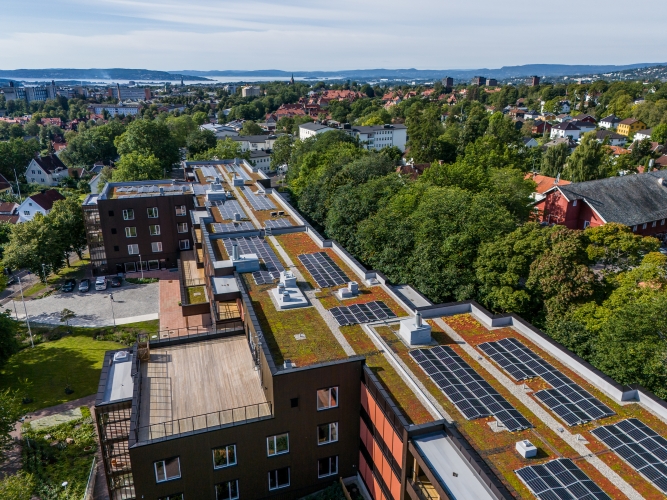To support climate friendly urban development, six municipalities in the Oslo region, Bergen, Trondheim, Stavanger and Kristiansand are collaborating on the FutureBuilt programme. Our vision is to show that climate neutral urban areas, based on high quality architecture, are possible.
Since the start of FutureBuilt in 2010, pilot projects have been used as a strategy for changing the way buildings and urban areas are developed, believing that good examples are important for making a change. Our goal is to complete 100 pilot projects that cut carbon emissions by at least 50% compared to current regulations and common practice. This is measured by a greenhouse gas accounting tool, and the reductions must be within the fields of transport, energy and materials.
By May 2025 FutureBuilt includes about 80 pilot projects – both public and commercial – dealing with neighborhoods, housing, schools, kindergartens, office buildings, cultural centres and cycling projects. 44 pilot projects are completed.
FutureBuilt criteria
Each pilot project needs to fulfil certain criteria. In addition to transport, energy and materials, the projects need to work with topics such as water management and biodiversity. To succeed in reducing the construction sectors´ climate footprint it is also crucial to shift the industry from linear use and production towards a more sustainable production based on recycling and reuse of existing building stock.
But building sustainably is not only about measuring greenhouse gas emissions – it is also about making attractive and livable neigbhourhoods and engaging residents and users in the development process.
Two of the FutureBuilt criteria are translated into English: FutureBuilt ZERO and FutureBuilt Circular. Please read more about the two criteria below.
FutureBuilt ZERO sets criteria for maximum emissions for a building's contribution to global warming potential over its lifetime and includes potential emission gains from carbon sequestration, reuse of materials, material recycling, and energy exports. Our goal is to always be 10 years ahead and 50% better than the rest of the construction industry. If you would like to know more about the FutureBuilt ZERO criteria, you can download the PDF below. Please note that this is not the latest version of the criteria.
FutureBuilt has recently released an updated version of FutureBuilt criteria for circular buildings. The goal of FutureBuilt Circular is to strive for 50 per cent circularity starting from 2020, with an increasing expectation of circularity in the future. If you would like to know more about the FutureBuilt circular criteria, you can donwlonad the PDF below. Please note that this is not the latest version of the criteria.
Target group
Our main target group are the developers, but finding new solutions first of all depends on a project group who is willing to go that extra mile looking for what is new. All FutureBuilt projects must have innovative showcase qualities, and for each project we discuss what new solutions can be explored and where there is a potential for breaking new ground. We aim high, but not so high that the goals are out of reach.
FutureBuilt receipe
So what is the FutureBuilt receipe? The process with the pilot projects follows more or less the same path:
- The first step is to establish contact between FutureBuilt and the developer, and the municipality also takes part in this dialogue.
- Then we start discussing the ambitions for the pilot project. If the project is ambitious enough the developer applies to join FutureBuilt.
- A committee led by the municipality decides if the project can join, and an agreement is signed between the developer, the municipality and FutureBuilt. The building application is given high priority by the municipality.
- Throughout the project period FutureBuilt serves the developer and the construction team with workshops to help the projects achieve their ambitious environmental targets.
- The developer uses a greenhouse gas accounting tool and estimates the carbon footprint for the pilot project. This is done for a reference building, the building as designed, as built and in use.
- And last, but not least – communication is central throughout the project period – not only on our website, but also through seminars and visits to the pilot projects.
Lesson learnt
So what is the lesson learnt from FutureBuilt?
Testing out new ways of building and constructing through pilot projects is an inspiring way of driving change. The pilot projects get a lot of attention, and we see a ripple effect where experiences from pilot projects have an impact on other projects.
The pioneers are eager to contribute to the change to the low carbon society, but the attention they get from media, politicians and professionals is of course also motivating. Many developers have chosen to do several FutureBuilt pilot projects because they see it as a useful process to improve their business, to attract highly qualified employees and to build an image as a responsible and forward thinking company.
We don´t say it is easy to be a pilot project, but it is not necessarily difficult either. Through FutureBuilt the developers are challenged to think differently, and with a little support from the best practioners, all the FutureBuilt pilots have given a contribution to the development of a low carbon construction business.
Partners
FutureBuilt has 10 partners: Oslo, Bærum, Asker, Drammen, Nordre Follo, Lillestrøm, Bergen, Trondheim, Stavanger and Kristiansand. In addition FutureBuilt collaborates closely with The Ministry of Local Government and Modernisation, the Norwegian State Housing Bank, Enova (Norwegian energy national fund), the National Office of Building Technology and Administration, the Green Building Alliance, the National Association of Norwegian Architectsand DOGA - Design and Architecture in Norway.
If you have any questions, please contact Pia Bodahl, Head of Communications.
